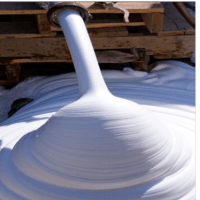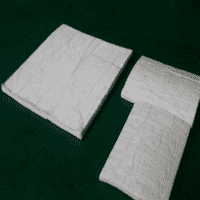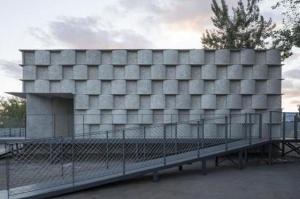Professional solutions on concrete addtives, Concrete Foaming Agent, Superplasticizer, CLC Blocks Additives, and foaming machine
(Synthetic based foaming agent was formulated through three successive processes for CLC application)
What is Foam agents?
Engineers used the CLC blocks for building wall materials because the CLC has a lower density than conventional clay bricks. The use of CLC blocks in buildings can reduce the load on the building. CLC is lighter than normal concrete and has low density, low cement and aggregate content in the mixture, thermal insulation, and sound suppression. Therefore, the CLC blocks have the advantage of saving time in installing building walls. In general, CLC has a larger size than clay bricks. So we have to adopt the mix ratio 1:3. Water cement ratio is 0.6. Mix-A – 100% cement, +100% fine aggregate + water + foaming agent-1%. Mix-B – 85% cement +15% fly ash +100% fine aggregate water foaming agent-1%. Bending strength is 15 to 20% of compressive strength, which is much lower than the AAC blocks. So, we can say that AAC blocks are superior to CLC blocks in terms of compressive strength.
CLC is known to be significant in structural and non-structural applications due to its various advantages. One component of CLC is the foaming agent, which is used to produce foam with a high level of stability and strength in preparation for CLC application. The purpose of this study is to formulate a synthetic-based foaming agent for CLC application. The synthetic-based foaming agent in application to CLC has a more stable foamed concrete and also has greater control over the density of the material. Different types of foaming agents, foam stabilizers, and dilution ratios were developed to formulate a synthetic-based foaming agent. Sodium lauryl sulfate, liquid detergent, and shampoo were selected for foaming agents; cetyl alcohol and sodium hydroxide for foam stabilizer; and a dilution ratio of 1:10, 1:25, and 1:40 were considered.
Synthetic based foaming agent was formulated through three successive processes for CLC application
The first process was the mixing of the foaming agent with stabilizer, coco diethanolamine (CDEA), and water, followed by foam testing, and lastly, the mixing of CLC with the formulated foaming agent. The formulation of the synthetic foaming agent was tested through a density test, stability test, and strength test. The application of a synthetic-based foaming agent to CLC was tested using the compressive strength test method. Results of mixing experiments showed that among the formulated foam mixtures used, liquid detergent as foaming agent with cetyl alcohol as foam stabilizer had the best results with a compressive strength of 4.30 MPa and 4.64 MPa for a dilution ratio of 1:10 and 1:25 respectively. The building consists of components of the foundation, columns, beams, walls, and roof. Walls are an essential part of a building. Most urban infrastructure in developing countries uses clay bricks as the primary material for building walls. The development of building materials science is growing with the discovery of various kinds of mixed materials to increase the strength of these materials. Nowadays, the development of materials science for building construction is starting to be made with lightweight foam concrete.
The effect of silica fume admixture on the compressive strength of the cellular lightweight concrete
The previous foam concrete studies with different addictive mixtures used recycled waste materials such as plastic waste and glass powder. The researchers studied foam concrete with recycled glass powder as a substitute for some cement to increase compressive strength. The glass particle size must be smaller than 45 millimicrons to fill the pores of the foam concrete and increase adhesion to the foam concrete. The development of foam concrete research is growing because foam concrete's matrix structure is more substantial than lightweight concrete. The addition of materials to the mix design can reduce the porosity of the CLC and increase the density of the material. The addition of ground calcium carbonate (GCC) and glass fiber (GF) to the mortar mix increases the compressive strength and flexural strength of the concrete. The development of building materials science is growing with the discovery of various kinds of additives in concrete mixtures to increase the strength of building structures. Efforts to increase the strength of concrete materials have been carried out by Ref. by replacing some cement with Granite Pulver (GP) of 5%, 10%, 15%, and 20% of the cement weight into the concrete mixture. The results showed an increase in concrete compressive strength of 1.6% and flexural strength of 6.8% due to a 15% Granite Pulver (GP) in the mixture. A mixture of foam concrete with polypropylene fibers, fly ash, and silica fume can produce high-strength lightweight concrete in building structures. Foam concrete with a density of 1000–1900 kg/m3 can increase the compressive strength by 10–70 MPa.
Price of Foam Concrete
Foam Concrete particle size and purity will affect the product's Price, and the purchase volume can also affect the cost of Foam Concrete. A large amount of large amount will be lower. The Price of Foam Concrete is on our company's official website.
Foam Concrete supplier
Luoyang Tongrun Nano Technology Co. Ltd. (TRUNNANO) Luoyang City, Henan Province, China, is a reliable and high-quality global chemical material supplier and manufacturer. It has more than 12 years of experience providing ultra-high quality chemicals and nanotechnology materials, including Foam Concrete, nitride powder, graphite powder, sulfide powder, and 3D printing powder. If you are looking for high-quality concrete additives, please feel free to contact us and send an inquiry. (sales@cabr-concrete.com). We accept payment via Credit Card, T/T, West Union, and Paypal. TRUNNANO will ship the goods to customers overseas through FedEx, DHL, by air, or by sea.
(Synthetic based foaming agent was formulated through three successive processes for CLC application)









